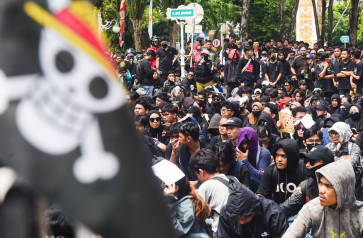Popular Reads
Top Results
Can't find what you're looking for?
View all search resultsPopular Reads
Top Results
Can't find what you're looking for?
View all search resultsIndonesia must reenergize its manufacturing sector
Poor performance: Pulogadung industrial estate in East Jakarta has for decades been an icon of industrialization in Jakarta
Change text size
Gift Premium Articles
to Anyone
 Poor performance: Pulogadung industrial estate in East Jakarta has for decades been an icon of industrialization in Jakarta. Labor laws and infrastructure deficiencies, however, have been blamed for the poor showing of Indonesian export-oriented manufacturing compared to the likes of Vietnam and Bangladesh. (JP/Wendra Ajistyatama) (JP/Wendra Ajistyatama)
Poor performance: Pulogadung industrial estate in East Jakarta has for decades been an icon of industrialization in Jakarta. Labor laws and infrastructure deficiencies, however, have been blamed for the poor showing of Indonesian export-oriented manufacturing compared to the likes of Vietnam and Bangladesh. (JP/Wendra Ajistyatama) (JP/Wendra Ajistyatama)
P
span class="caption" style="width: 596px;">Poor performance: Pulogadung industrial estate in East Jakarta has for decades been an icon of industrialization in Jakarta. Labor laws and infrastructure deficiencies, however, have been blamed for the poor showing of Indonesian export-oriented manufacturing compared to the likes of Vietnam and Bangladesh. (JP/Wendra Ajistyatama)
Competition is fierce and Indonesia needs to strive to differentiate itself.
Indonesia aspires to become a nation that is politically strong and stable, with a vibrant democracy and a respect for human rights even before it reaches 100 years old in 2045. More importantly, it should have a strong, dynamic economy and have confidence that businesses will provide citizens with a high standard of living while pursuing innovation that will keep Indonesia constantly ahead of the game. This it cannot do without a sizeable manufacturing sector, one that is dynamic and competitive so that both export-oriented and domestic-focused manufacturing thrive. In recent years, Indonesia has done well in domestic-focused manufacturing but has lost its edge in manufacturing for export.
Of course, Indonesia has come a long way since the 1997-1998 Asian financial crisis and has shown a capacity for managing the many shocks that have confronted it since. It even came through the 2008 global financial crisis relatively well. Moreover, the sharp depreciation in the rupiah last year has been partly reversed as the nation's external accounts have improved, allowing foreign reserves to surge once again. Nevertheless, manufacturing has been held back by a few major structural problems.
First, Indonesia's infrastructure development remains poor -- a common complaint among private investors ' due to under-investment. Second, Indonesia suffers from widespread corruption, as shown in the annual perception index of the Berlin-based Transparency International. Third, its labor legislation needs to be made more flexible, as Indonesia currently provides overly generous provisions for employment-termination and faces frequent labor strikes. Furthermore, there is a problem of structural unemployment where there is a mismatch of labor skills to the available jobs.
All these issues translate into Indonesia's underperformance in the competitiveness rankings. A lack of competitiveness means losing vital export business and becoming less attractive for foreign direct investment (FDI), both of which are needed to revitalize the manufacturing sector. In the World Economic Forum Competitiveness Index, Indonesia is ranked 38th compared to Singapore's second place and Malaysia's 24th. Furthermore, in the World Bank Doing Business Indicator, Indonesia is ranked in 120th place compared to Singapore's first-place ranking and Malaysia in sixth place.
In the early 1980s, Indonesia accounted for more then 24 percent of ASEAN's total exports and almost 6 percent of Asia's exports, on average. However, in recent years, its share has fallen by more than half, to about 12 percent and 3 percent, respectively. While Indonesia's manufacturing sector has stagnated, countries like Vietnam have industrialized rapidly, catching up or even overtaking Indonesia. Furthermore, Indonesia's ability to attract FDI has diminished. Once commanding an average of 21 percent of Asia's FDI between 1971 and 1980, its share dwindled to an average of 1 percent over the past 10 years. Its failure to attract FDI is a major setback, as FDI is vital to jump-starting Indonesia's economy, climbing up the value chain and improving competitiveness.
Partly as a result of the lack of manufacturing-sector growth, real GDP growth continues to underperform its pre-1997 rates, when Indonesia was lauded as an 'Asian Tiger' and vast numbers of Indonesians were lifted out of poverty. This has had a direct impact on the welfare of the common citizen. Furthermore, real gross national income (GNI) per capita is still very low compared to that of Indonesia's neighbors, which indicates the country still has much catching up to do. While its poverty rate has improved since 1990, it still sits at 10 percent and is higher than the poverty rate in Vietnam. According to the UN Human Development Index, Indonesia is ranked 121st, far below the median, behind countries such as Thailand, the Philippines and China. If Indonesia fixes its structural problems, it could realize its growth potential and achieve much more than it has to date.
There are multiple areas that Indonesia can focus on, but manufacturing is the key.
Developing the manufacturing industry will be the fastest way to create jobs and establish a well-rounded economy for Indonesia. First, Indonesia has a population of 247 million and, according to recent data, the average monthly wage for a manufacturing worker is just US$155 per month. Due to these low costs, Indonesia could be an ideal place for labor-intensive manufacturing to operate. Workers in manufacturing receive higher wages on average than those in other sectors. Furthermore, as the manufacturing industry develops, Indonesia will have a highly skilled vocational labor force with a higher standard of living.
Second, a well-conceived manufacturing policy with adequate infrastructure in place would aid in attracting FDI into the country. FDI brings not only financial capital into Indonesia but also technology and expertise, which otherwise would cost Indonesia significant time and resources to acquire. This would help accelerate growth in the economy.
Third, the manufacturing industry not only generates economic activity on its own, but also supports many non-manufacturing sectors, from industries higher up the supply chain, such as mining, as well as those further downstream, such as warehousing. Other external services like engineering and financial and legal services will develop alongside manufacturing. Manufacturing even supports national defense and homeland security as it provides the suitable technology for such sectors.
Last, it is important for Indonesia to constantly innovate and adapt to the world. Manufacturing can give it that ability. It is proven that manufacturing helps spur innovation. In the US, two-thirds of research and development spending and 60 percent of royalties go into manufacturing. These technologies would give Indonesia an edge in the future and help identify areas where the country has competitive advantages.
With good policies Indonesia can seize on the exciting new opportunities that are arising.
Geographically, Indonesia is close to the huge markets of India and China and in 2015, the country will have access to the ASEAN Economic Community (AEC). Combined, the populations of India and China make up 37 percent of the world's total population. Hence, the rise of these large domestic markets and their consumer classes provide an excellent opportunity for Indonesia's exports.
Furthermore, the implementation of the AEC later in 2015, which will create a single market and production base, will allow Indonesia to unlock economic synergies within the region. It will also provide access to technology, investments, transportation links and consumer bases, creating a perfect opportunity to kick-start Indonesia's growth. Furthermore, as a region, Indonesia will benefit from strong trade ties with India and China through ASEAN's free trade agreements with those nations.
In the wider context, as China moves up the value chain and redirects its focus toward services, its labor-intensive industries are likely to be outsourced. Indonesia can take advantage of this shift and become a new low-cost base for companies.
As geopolitical tensions rise with China, Japan is seeking to woo and exert influence in the Asia-Pacific region, which could benefit Indonesia. For example, Japan is going to aid Indonesia in the development of maritime infrastructure and the construction of deep-sea ports. Inland, Japan is also considering helping in the development of transportation projects to ease congestion. While it is in Japan's interest politically, such aid would also benefit Japan economically, as it has an abundance of investments in Indonesia that are affected by poor infrastructure, thus killing two birds with one stone.
Prudent innovation has been a strength of emerging economies such as India and China. The emergence of Xiaomi, a low-cost smartphone from China, and the Tata Nano, a low-cost car in India, are some successes that are possible for Indonesia to emulate. From there, Indonesia could produce affordable products for domestic use and there is a distinct opportunity to export such goods.
There are challenges
Recent years have seen a reversal of the earlier trend of developed countries relocating production to low-cost economies. Though still early and restricted to a few industries, rising productivity in developed countries, increased costs in transportation and the lack of managerial oversight at foreign manufacturing bases have encouraged a shift of production back to developed countries.
For example, Ford Motor Co. moved jobs back to America in 2010, along with companies such as General Electric, Caterpillar Inc. and Volkswagen, cutting back on outsourcing trends. Sleek Audio also shifted production back home after defective units manufactured in China cost companies millions of dollars.
Furthermore, Indonesia is not alone in terms of low wages or geographical advantages. Countries like India have renewed their efforts to boost manufacturing, attracting investors who wish to be close to their targeted consumers and places where they can access economies of scale. Furthermore, once-laggard countries such as Brazil, Bangladesh and some African nations are making a comeback as outsourcing corporations seek more cost-effective production regions. As such, the competition is fierce and Indonesia needs to strive to differentiate itself and identify areas where it has a competitive advantage. Without doing so, Indonesia will not succeed.
So far export-orientated manufacturing has performed rather poorly in Indonesia, with the relocation of labor-intensive manufacturing from China going mostly to Bangladesh, Vietnam and other countries rather than to Indonesia. Investors are often wary of Indonesia due to its poor infrastructure and labor laws. It is estimated that Rp 12.8 trillion per year is lost due to traffic congestion. Indonesia's ports are running at full capacity and yet there is oversaturation in cities. The high frequency of radical industrial actions and the overly rigid labor laws also discourage investors from entering Indonesia. Furthermore, protectionist policies that remain in place have greatly hurt Indonesia's opportunities, as some investors have taken the country off their radar.
What Indonesia must do and what it must avoid
Indonesia needs to take vigorous measures to create the right environment for growth.
First, Indonesia must reform its regulatory environment and raise the governance standards that turn investors away.
Second, it needs to tackle the infrastructure deficiencies that raise costs and obstruct trade.
Third, it needs to improve the quality of human capital so as to boost productivity.
Fourth, Indonesia needs to incentivize greater innovation among firms to enable them to move up the value chain in the manufacturing sector.
Fifth, it needs to strengthen the currently weak funding mechanisms that harm smaller manufacturers.
Lastly, Indonesia has to liberalize the overly rigid labor market that discourages investment in labor-intensive manufacturing in order to promote higher-wage employment growth. These are the foundations that are essential to implementing any industrial policy that Indonesia chooses to pursue.
While there are many things Indonesia needs to work on, there are also several policies that it should avoid, such as poorly designed protectionist and import-substitution polices. The historical experience suggests that while an inward-looking protectionist strategy might generate rapid growth initially, eventually the lack of competition-driven innovation creates inefficient industries that never quite mature. This is the lesson Indonesia learned from past experience when approvals of foreign investment were granted only in cases of joint ventures with majority-Indonesian ownership.
For example, the protection of the automotive and steel industries led to complacency within local firms, resulting in weak innovation. Not surprisingly, the output growth of the automotive industry was so poor that costs were not covered and export volumes for components and vehicles were insignificant to the economy.
Important elements used in other industries such as steel turned out to suffer not from inflated prices but poor quality, hurting domestic industries that used steel. Even with government intervention, these industrial policies failed to produce any 'national champions', such that the policies became pointless and counter-productive.
In conclusion, Indonesia needs a strong manufacturing sector ' one that can compete globally ' if it is to provide enough jobs with adequate incomes for its rapidly growing workforce. The measures needed to achieve this are well known but somehow never sufficiently implemented. Now is the time to redouble efforts and get Indonesia on track to becoming the manufacturing powerhouse it can be.









